wheel TOYOTA COROLLA 2020 Warranties & Maintenance Guides (in English)
[x] Cancel search | Manufacturer: TOYOTA, Model Year: 2020, Model line: COROLLA, Model: TOYOTA COROLLA 2020Pages: 260, PDF Size: 8.54 MB
Page 69 of 260
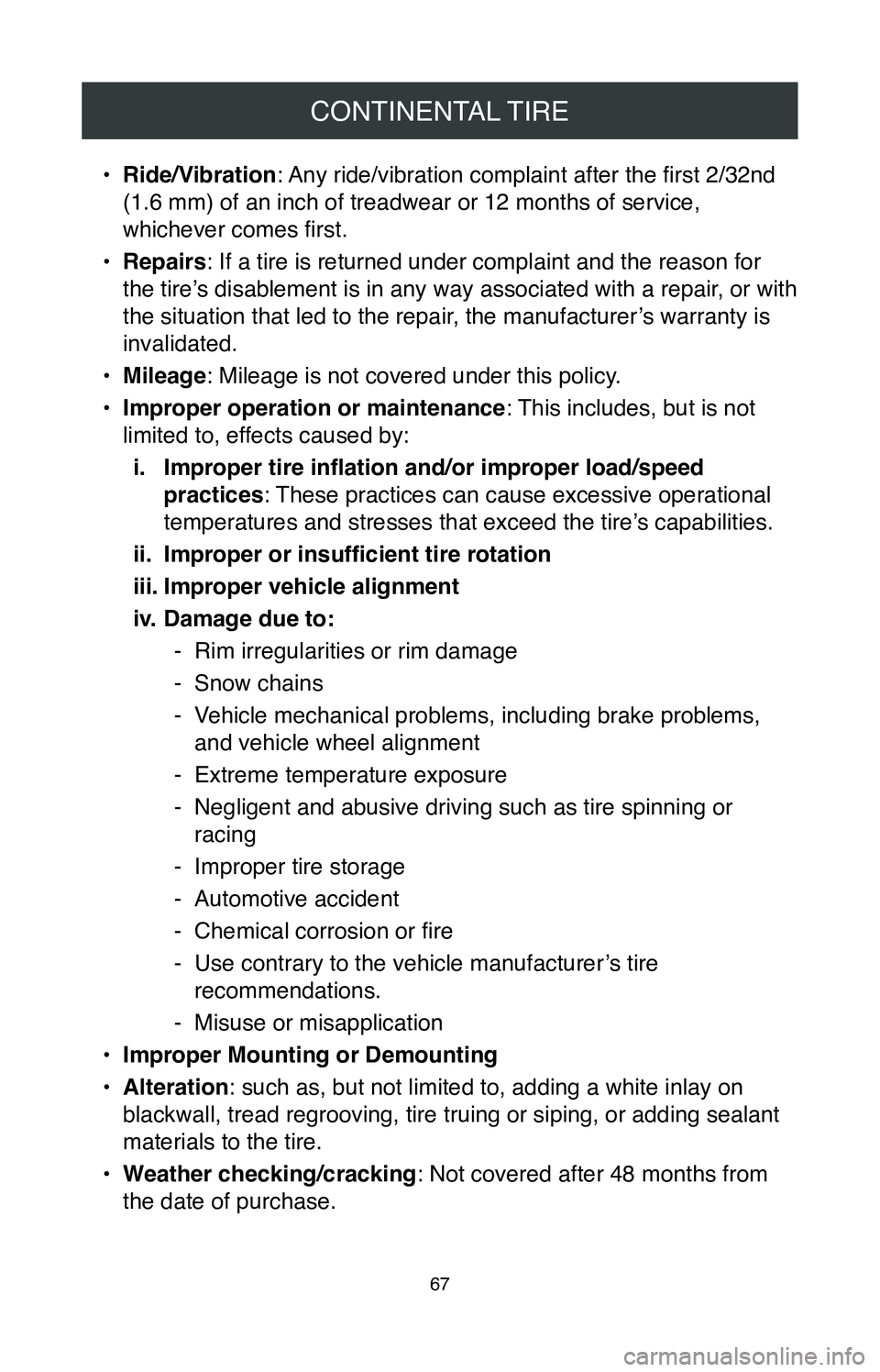
CONTINENTAL TIRE
67
• Ride/Vibration: Any ride/vibration complaint after the first 2/32nd
(1.6 mm) of an inch of treadwear or 12 months of service,
whichever comes first.
•
Repairs: If a tire is returned under complaint and the reason for
the tire’s disablement is in any way associated with a repair, or with
the situation that led to the repair, the manufacturer’s warranty is
invalidated.
•
Mileage: Mileage is not covered under this policy.
•
Improper operation or maintenance : This includes, but is not
limited to, effects caused by:
i.
Improper tire inflation and/or improper load/speed
practices : These practices can cause excessive operational
temperatures and stresses that exceed the tire’s capabilities.
ii.
Improper or insufficient tire rotation
iii.
Improper vehicle alignment
iv.
Damage due to:
- Rim irregularities or rim damage
-Snow chains
-Vehicle mechanical problems, including brake problems,
and vehicle wheel alignment
-Extreme temperature exposure
-Negligent and abusive driving such as tire spinning or
racing
-Improper tire storage
-Automotive accident
- Chemical corrosion or fire
- Use contrary to the vehicle manufacturer’s tire
recommendations.
-Misuse or misapplication
•
Improper Mounting or Demounting
•
Alteration: such as, but not limited to, adding a white inlay on
blackwall, tread regrooving, tire truing or siping, or adding sealant
materials to the tire.
•
Weather checking/cracking: Not covered after 48 months from
the date of purchase.
Page 76 of 260

FALKEN
74
Original Equipment Limited Warranty and Tire
Care Guide
Tire Care and Recommendations
Proper Inflation and Fuel Economy
Ensure maximum performance and a long life from your tires by
checking the air pressures at least once a month and set them to
the vehicle manufacturer’s recommended pressure(s) listed on the
vehicle’s tire placard or in your owner’s manual. Always check and
adjust your air pressure when your tires are cold, preferably first thing
in the morning before driving. Never release air pressure from tires
when they are hot. Wait until the tires cool down and recheck, adding
air or releasing as required. Falken endorses the use of nitrogen in
your tires because it helps your tires maintain optimal pressure for
longer periods of time and reduces the amount of moisture inside of
the tire and wheel assembly.
*Some plus size applications may require different air pressure(s)
than what is listed on your vehicle’s placard or owner’s manual. In this
case, please consult your tire dealer or Falken Tires for proper inflation
pressure(s).
Tire Inflation Pressure
Tires need to be properly inflated to effectively operate and perform
as intended. Tires carry the weight of the vehicle, passengers, and
cargo as well as bear the forces of braking, accelerating, and turning. \
The vehicle manufacturer sets the inflation pressures for the original
equipment tires that are on your vehicle.
Driving with improperly inflated tires is dangerous. An under inflated
tire will generate excessive heat build-up that will cause damage to
the internal structure and inner liner of the tire. Besides tire damage,\
improper tire inflation pressures can also affect your vehicle’s ride
and handling, tire tread wear, and fuel economy. It is recommended
to always keep all of your tires, including the spare, at the vehicle
manufacturer’s recommended inflation pressures and be sure to check
the air pressure monthly and before going on long road trips or carrying
extra weight in your vehicle.
Page 79 of 260
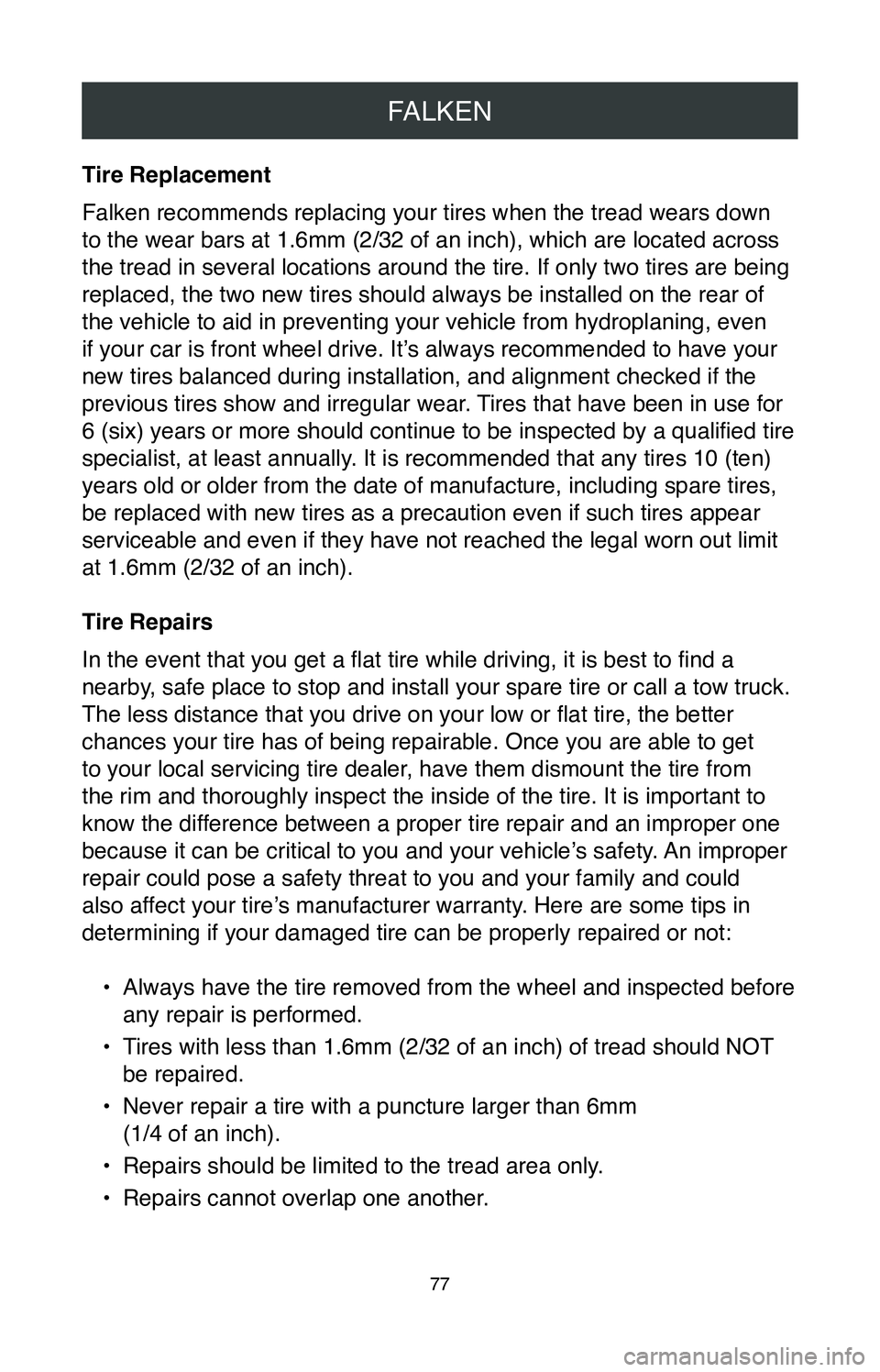
FALKEN
77
Tire Replacement
Falken recommends replacing your tires when the tread wears down
to the wear bars at 1.6mm (2/32 of an inch), which are located across
the tread in several locations around the tire. If only two tires are be\
ing
replaced, the two new tires should always be installed on the rear of
the vehicle to aid in preventing your vehicle from hydroplaning, even
if your car is front wheel drive. It’s always recommended to have your
new tires balanced during installation, and alignment checked if the
previous tires show and irregular wear. Tires that have been in use for
6 (six) years or more should continue to be inspected by a qualified tire
specialist, at least annually. It is recommended that any tires 10 (ten)
years old or older from the date of manufacture, including spare tires, \
be replaced with new tires as a precaution even if such tires appear
serviceable and even if they have not reached the legal worn out limit
at 1.6mm (2/32 of an inch).
Tire Repairs
In the event that you get a flat tire while driving, it is best to find a
nearby, safe place to stop and install your spare tire or call a tow truck.
The less distance that you drive on your low or flat tire, the better
chances your tire has of being repairable. Once you are able to get
to your local servicing tire dealer, have them dismount the tire from
the rim and thoroughly inspect the inside of the tire. It is important t\
o
know the difference between a proper tire repair and an improper one
because it can be critical to you and your vehicle’s safety. An improper
repair could pose a safety threat to you and your family and could
also affect your tire’s manufacturer warranty. Here are some tips in
determining if your damaged tire can be properly repaired or not:•
Always have the tire removed from the wheel and inspected before
any repair is performed.
•
Tires with less than 1.6mm (2/32 of an inch) of tread should NOT
be repaired.
•
Never repair a tire with a puncture larger than 6mm
(1/4 of an inch).
•
Repairs should be limited to the tread area only.
•
Repairs cannot overlap one another.
Page 81 of 260
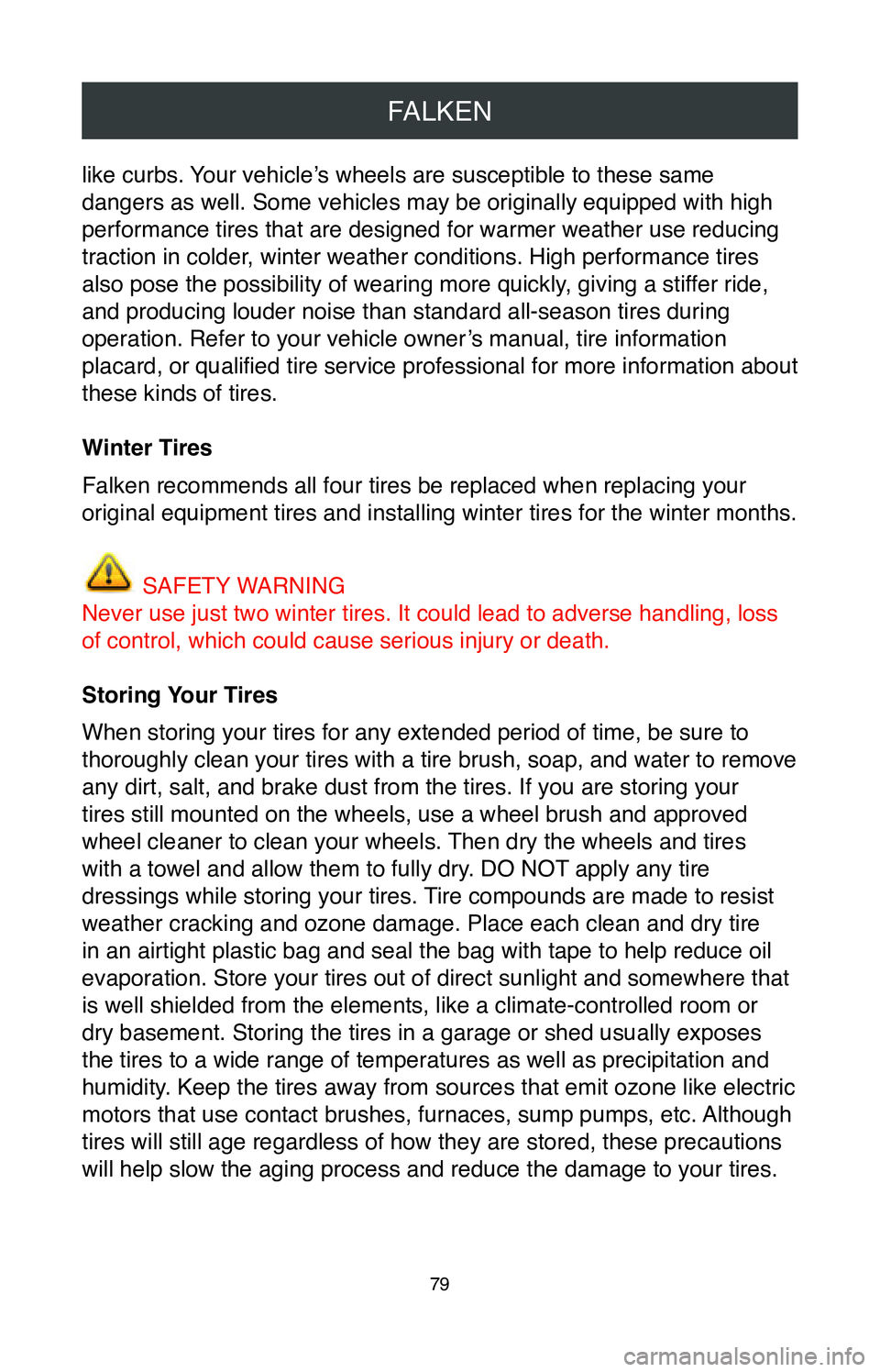
FALKEN
79
like curbs. Your vehicle’s wheels are susceptible to these same
dangers as well. Some vehicles may be originally equipped with high
performance tires that are designed for warmer weather use reducing
traction in colder, winter weather conditions. High performance tires
also pose the possibility of wearing more quickly, giving a stiffer ride,
and producing louder noise than standard all-season tires during
operation. Refer to your vehicle owner’s manual, tire information
placard, or qualified tire service professional for more information about
these kinds of tires.
Winter Tires
Falken recommends all four tires be replaced when replacing your
original equipment tires and installing winter tires for the winter mont\
hs.
SAFETY WARNING
Never use just two winter tires. It could lead to adverse handling, loss
of control, which could cause serious injury or death.
Storing Your Tires
When storing your tires for any extended period of time, be sure to
thoroughly clean your tires with a tire brush, soap, and water to remove\
any dirt, salt, and brake dust from the tires. If you are storing your
tires still mounted on the wheels, use a wheel brush and approved
wheel cleaner to clean your wheels. Then dry the wheels and tires
with a towel and allow them to fully dry. DO NOT apply any tire
dressings while storing your tires. Tire compounds are made to resist
weather cracking and ozone damage. Place each clean and dry tire
in an airtight plastic bag and seal the bag with tape to help reduce oil\
evaporation. Store your tires out of direct sunlight and somewhere that \
is well shielded from the elements, like a climate-controlled room or
dry basement. Storing the tires in a garage or shed usually exposes
the tires to a wide range of temperatures as well as precipitation and
humidity. Keep the tires away from sources that emit ozone like electric
motors that use contact brushes, furnaces, sump pumps, etc. Although
tires will still age regardless of how they are stored, these precaution\
s
will help slow the aging process and reduce the damage to your tires.
Page 83 of 260
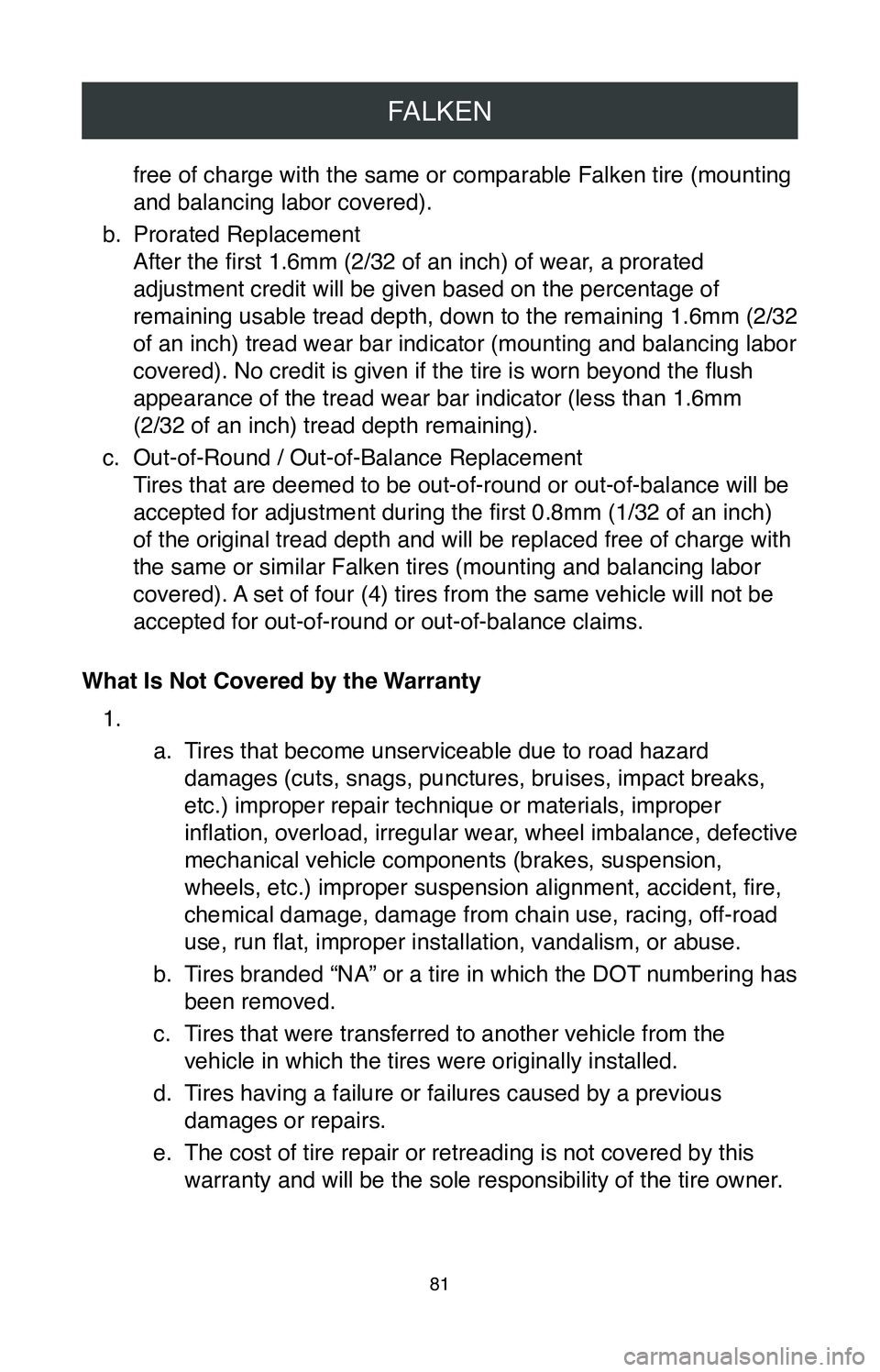
FALKEN
81
free of charge with the same or comparable Falken tire (mounting
and balancing labor covered).
b.
Prorated Replacement
After the first 1.6mm (2/32 of an inch) of wear, a prorated
adjustment credit will be given based on the percentage of
remaining usable tread depth, down to the remaining 1.6mm (2/32
of an inch) tread wear bar indicator (mounting and balancing labor
covered). No credit is given if the tire is worn beyond the flush
appearance of the tread wear bar indicator (less than 1.6mm
(2/32 of an inch) tread depth remaining).
c.
Out-of-Round / Out-of-Balance Replacement
Tires that are deemed to be out-of-round or out-of-balance will be
accepted for adjustment during the first 0.8mm (1/32 of an inch)
of the original tread depth and will be replaced free of charge with
the same or similar Falken tires (mounting and balancing labor
covered). A set of four (4) tires from the same vehicle will not be
accepted for out-of-round or out-of-balance claims.
What Is Not Covered by the Warranty 1.
a. Tires that become unserviceable due to road hazard
damages (cuts, snags, punctures, bruises, impact breaks,
etc.) improper repair technique or materials, improper
inflation, overload, irregular wear, wheel imbalance, defective
mechanical vehicle components (brakes, suspension,
wheels, etc.) improper suspension alignment, accident, fire,
chemical damage, damage from chain use, racing, off-road
use, run flat, improper installation, vandalism, or abuse.
b.
Tires branded “NA” or a tire in which the DOT numbering has
been removed.
c.
Tires that were transferred to another vehicle from the
vehicle in which the tires were originally installed.
d.
Tires having a failure or failures caused by a previous
damages or repairs.
e.
The cost of tire repair or retreading is not covered by this
warranty and will be the sole responsibility of the tire owner.
Page 88 of 260
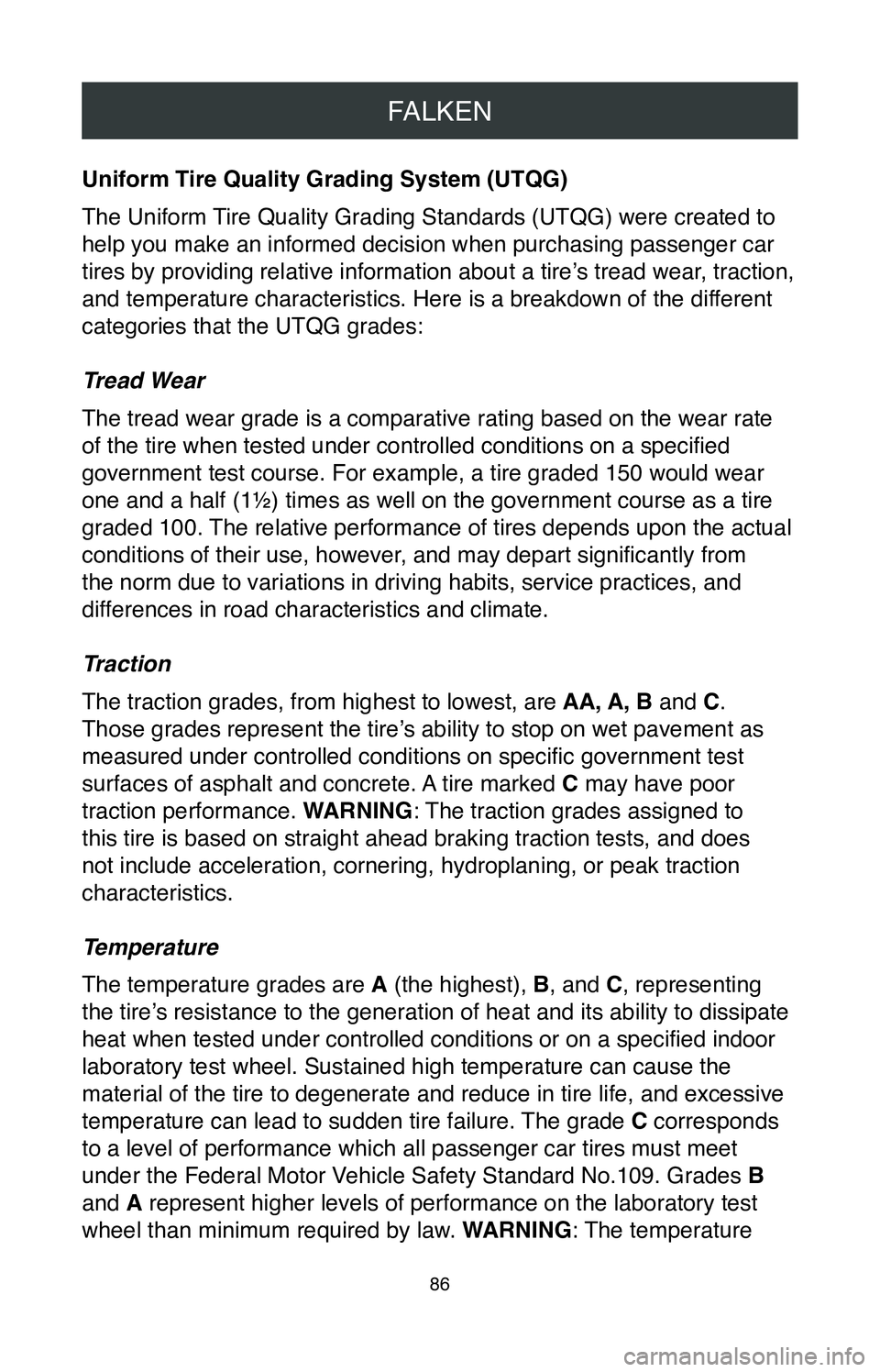
FALKEN
86
Uniform Tire Quality Grading System (UTQG)
The Uniform Tire Quality Grading Standards (UTQG) were created to
help you make an informed decision when purchasing passenger car
tires by providing relative information about a tire’s tread wear, traction,
and temperature characteristics. Here is a breakdown of the different
categories that the UTQG grades:
Tread Wear
The tread wear grade is a comparative rating based on the wear rate
of the tire when tested under controlled conditions on a specified
government test course. For example, a tire graded 150 would wear
one and a half (1½) times as well on the government course as a tire
graded 100. The relative performance of tires depends upon the actual
conditions of their use, however, and may depart significantly from
the norm due to variations in driving habits, service practices, and
differences in road characteristics and climate.
Traction
The traction grades, from highest to lowest, are AA, A, B and C.
Those grades represent the tire’s ability to stop on wet pavement as
measured under controlled conditions on specific government test
surfaces of asphalt and concrete. A tire marked C may have poor
traction performance. WARNING: The traction grades assigned to
this tire is based on straight ahead braking traction tests, and does
not include acceleration, cornering, hydroplaning, or peak traction
characteristics.
Temperature
The temperature grades are A (the highest), B, and C, representing
the tire’s resistance to the generation of heat and its ability to dissipate
heat when tested under controlled conditions or on a specified indoor
laboratory test wheel. Sustained high temperature can cause the
material of the tire to degenerate and reduce in tire life, and excessiv\
e
temperature can lead to sudden tire failure. The grade C corresponds
to a level of performance which all passenger car tires must meet
under the Federal Motor Vehicle Safety Standard No.109. Grades B
and A represent higher levels of performance on the laboratory test
wheel than minimum required by law. WARNING: The temperature
Page 92 of 260

GOODYEAR / DUNLOP
90
tire at the time of adjustment. If the price of the comparable tire is
$400.00, the cost to you would be $200.00 plus Federal Excise Tax
(U.S. only), mounting, balancing, any other applicable taxes and
government- mandated charges.
(Plus FET [U.S. only], other applicable taxes, government- mandated
charges and mounting and balancing.)
What Is a Comparable Tire?
A “comparable” new Goodyear tire may be either the same line of
tire or, in the event that the same tire is not available, a tire of the
same basic construction and quality with a different sidewall or tread
configuration. If a higher priced tire is accepted as replacement, the
difference in price will be at an additional charge to you.
Any replacement tire provided pursuant to this warranty will be covered \
by the Goodyear warranty in effect at the time of replacement.
What Is Not Covered Under This Limited Warranty?
• Wear conditions or tire damage due to road hazards (including
punctures, cuts, snags, impact breaks, etc.). Wreck, collision, or
fire. Fast wear, irregular wear, heel and toe wear or other wear
conditions.
•
Improper inflation, overloading, high-speed spinup, misapplication,
misuse, negligence, racing, chain damage, or improper mounting
or demounting.
•
Mechanical condition of the vehicle.
•
Chip/chunk conditions on tires intended for highway service.
•
Ride disturbance after the first 2/32” (inch) treadwear or due to
damaged wheels or any vehicle condition.
•
Any tire intentionally altered after leaving a factory producing
Page 98 of 260

GOODYEAR / DUNLOP
96
• FAILURE TO MOUNT RADIAL TIRES ON APPROVED RIMS.
•
FAILURE TO DEFLATE SINGLE OR DUAL ASSEMBLIES
COMPLETELY BEFORE DEMOUNTING.
•
TIRE SPINNING. On slippery surfaces such as snow, mud, ice,
etc., do not spin tires in excess of 35 mph (56 kph), as indicated on
the speedometer.
•
EXCESSIVE WHEEL SPINNING. This can also result in tire
disintegration or axle failure.
For Service Assistance or Information:
1. First contact the nearest Authorized Goodyear Commercial
Tire Retailer.
2.
If additional assistance is required:
- In the U.S., write to:
Goodyear Customer Assistance Center
Department 728
200 Innovation Way
Akron, OH 44316
-In Canada, write to:
Goodyear Customer Assistance Center
450 Kipling Avenue
Toronto, Ont. M8Z 5E1
Page 100 of 260
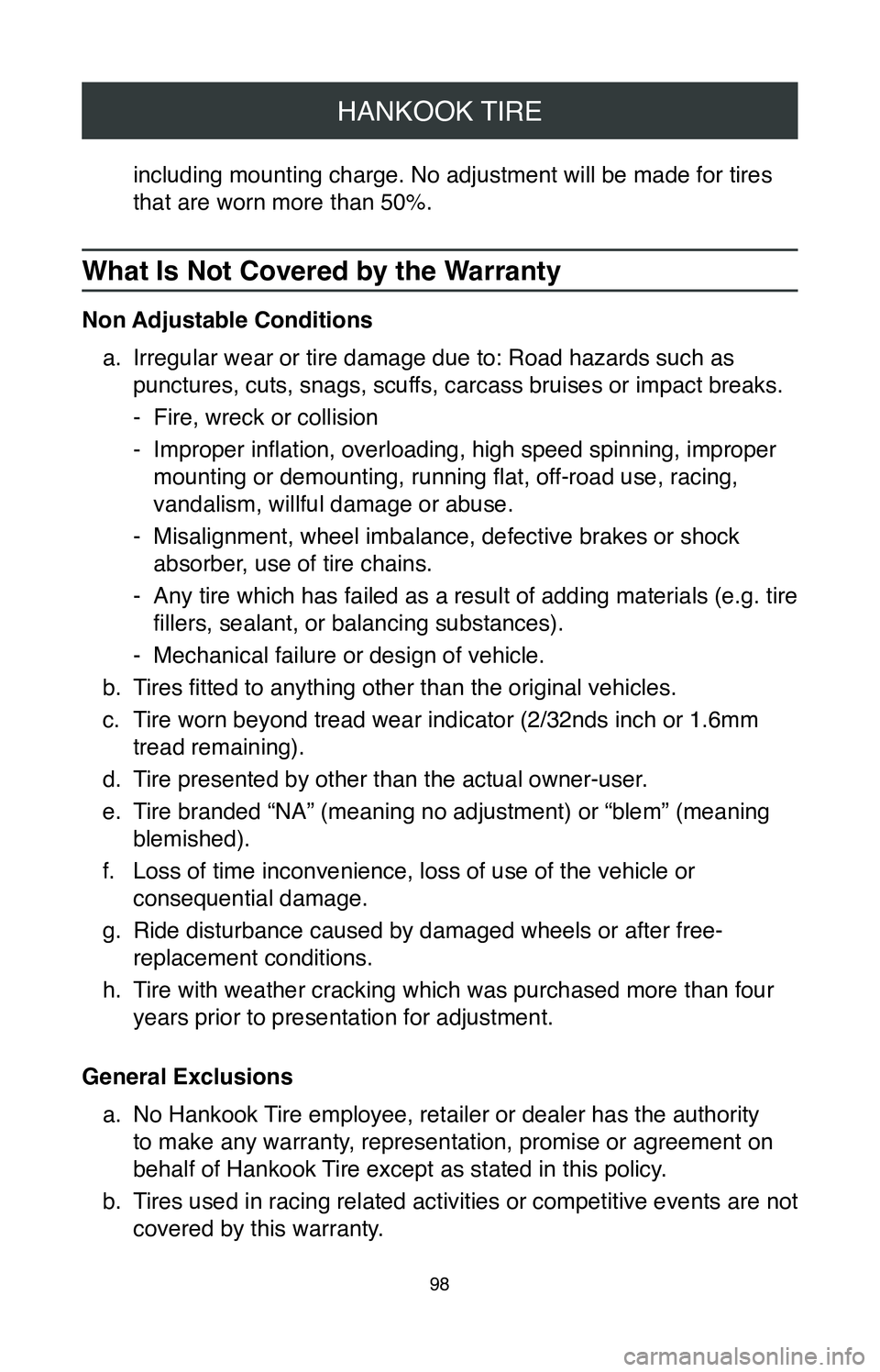
HANKOOK TIRE
98
including mounting charge. No adjustment will be made for tires
that are worn more than 50%.
What Is Not Covered by the Warranty
Non Adjustable Conditionsa.
Irregular wear or tire damage due to: Road hazards such as
punctures, cuts, snags, scuffs, carcass bruises or impact breaks.
-Fire, wreck or collision
- Improper inflation, overloading, high speed spinning, improper
mounting or demounting, running flat, off-road use, racing,
vandalism, willful damage or abuse.
-Misalignment, wheel imbalance, defective brakes or shock
absorber, use of tire chains.
- Any tire which has failed as a result of adding materials (e.g. tire
fillers, sealant, or balancing substances).
-Mechanical failure or design of vehicle.
b.
Tires fitted to anything other than the original vehicles.
c.
Tire worn beyond tread wear indicator (2/32nds inch or 1.6mm
tread remaining).
d.
Tire presented by other than the actual owner-user.
e.
Tire branded “NA” (meaning no adjustment) or “blem” (meaning
blemished).
f.
Loss of time inconvenience, loss of use of the vehicle or
consequential damage.
g.
Ride disturbance caused by damaged wheels or after free-
replacement conditions.
h.
Tire with weather cracking which was purchased more than four
years prior to presentation for adjustment.
General Exclusions a.
No Hankook Tire employee, retailer or dealer has the authority
to make any warranty, representation, promise or agreement on
behalf of Hankook Tire except as stated in this policy.
b.
Tires used in racing related activities or competitive events are not
covered by this warranty.
Page 103 of 260
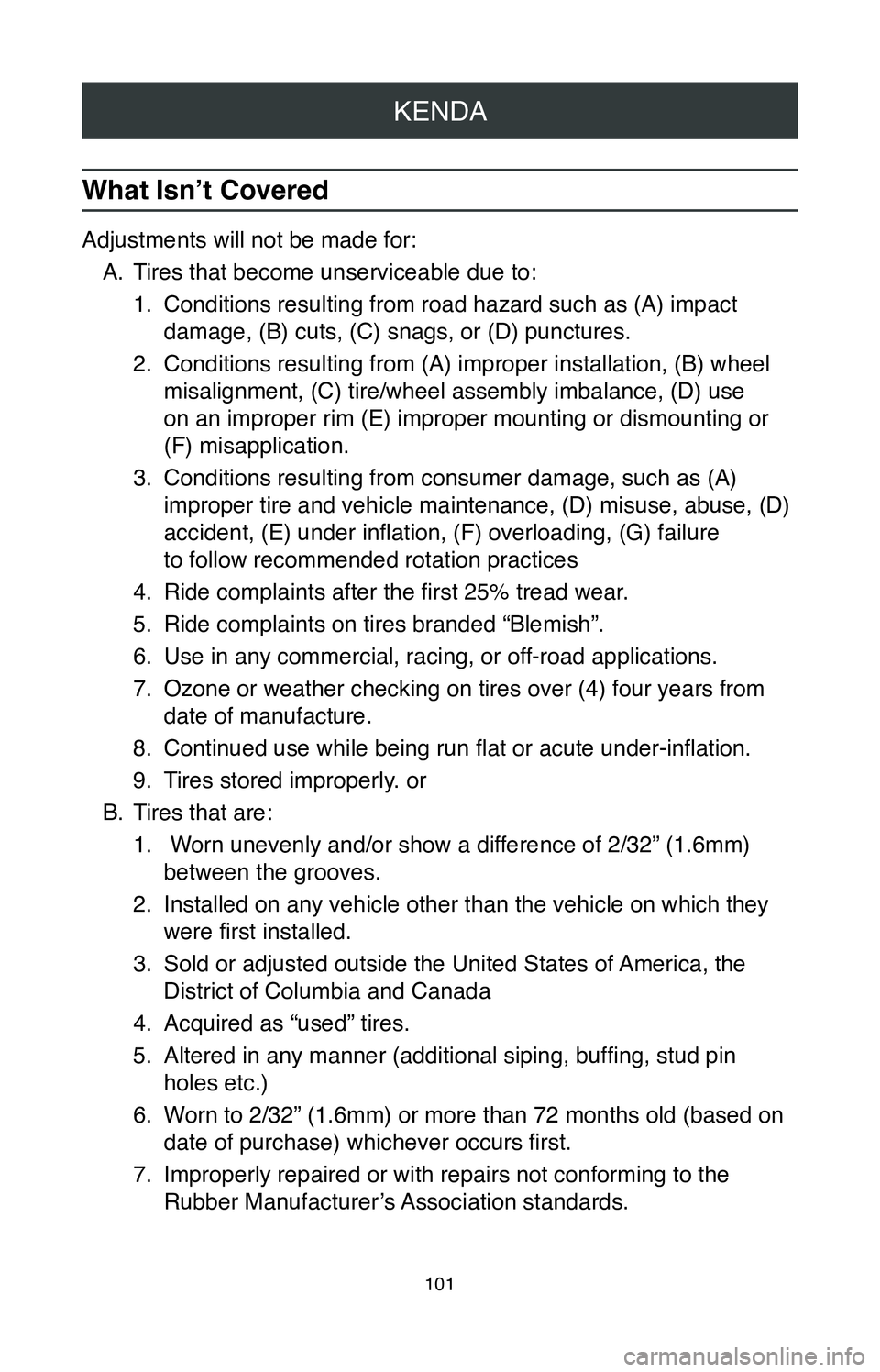
KENDA
101
What Isn’t Covered
Adjustments will not be made for:A.
Tires that become unserviceable due to:
1.
Conditions resulting from road hazard such as (A) impact
damage, (B) cuts, (C) snags, or (D) punctures.
2.
Conditions resulting from (A) improper installation, (B) wheel
misalignment, (C) tire/wheel assembly imbalance, (D) use
on an improper rim (E) improper mounting or dismounting or
(F) misapplication.
3.
Conditions resulting from consumer damage, such as (A)
improper tire and vehicle maintenance, (D) misuse, abuse, (D)
accident, (E) under inflation, (F) overloading, (G) failure
to follow recommended rotation practices
4.
Ride complaints after the first 25% tread wear.
5.
Ride complaints on tires branded “Blemish”.
6.
Use in any commercial, racing, or off-road applications.
7.
Ozone or weather checking on tires over (4) four years from
date of manufacture.
8.
Continued use while being run flat or acute under-inflation.
9.
Tires stored improperly. or
B.
Tires that are:
1.
Worn unevenly and/or show a difference of 2/32” (1.6mm)
between the grooves.
2.
Installed on any vehicle other than the vehicle on which they
were first installed.
3.
Sold or adjusted outside the United States of America, the
District of Columbia and Canada
4.
Acquired as “used” tires.
5.
Altered in any manner (additional siping, buffing, stud pin
holes etc.)
6.
Worn to 2/32” (1.6mm) or more than 72 months old (based on
date of purchase) whichever occurs first.
7.
Improperly repaired or with repairs not conforming to the
Rubber Manufacturer’s Association standards.